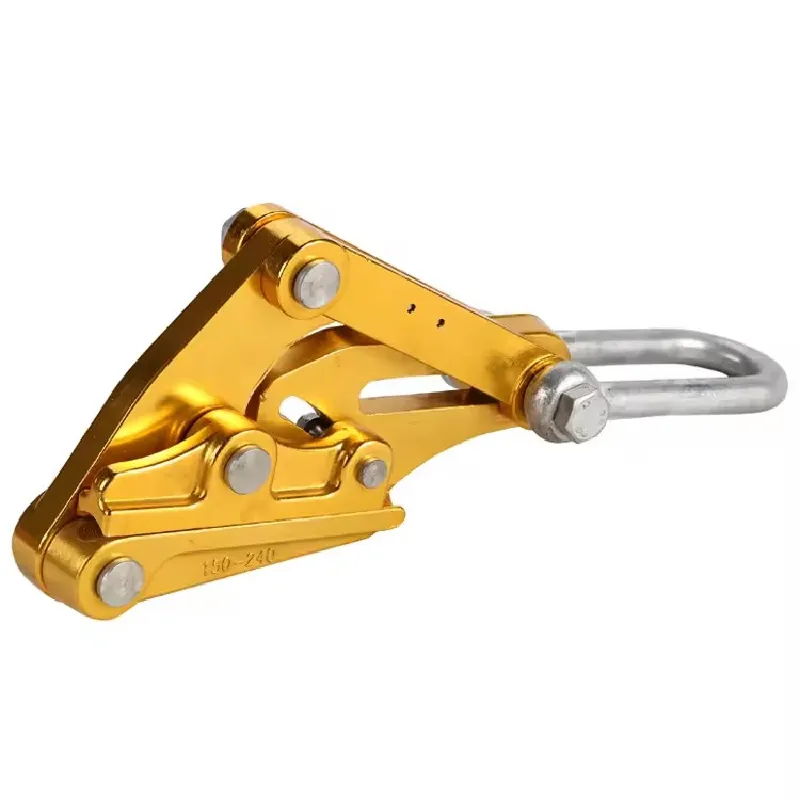


Oct . 26, 2025 13:00 Back to list
Cable Pulling Tools – Durable, Efficient & Safe for Pros
Field Notes from the Line: Why Good Cable Pulling Tools Save Time—and Conductors
Out on stringing sites and substation fly-ins, the tools that quietly matter most are the grips and clamps. If you’ve ever watched a conductor get chewed up by a bad jaw, you remember it—expensive and embarrassing. Among Cable Pulling Tools, the unsung workhorse is the Cable Wire Grip Come Along Clamp: forged aluminum alloy, light in the hand, and—when it’s done right—gentle on AAAC/ACSR and optical ground wire while still biting hard enough to hold.

What’s different about forged aluminum grips?
This particular clamp is forged from high-strength aluminum alloy, then precision-machined. The aim is simple: serious strength-to-weight, plus jaw geometry that won’t mar conductor strands. The maker is based in China, and in my notebook the first thing that stood out was the finish—clean forging lines and consistent serrations. Many customers say it “just feels lighter” on tower climbs; that matters at hour nine of a pull.
Typical applications
- Clamping steel strand, traction wire rope, and aluminum alloy conductors
- OGW/OPGW handling on transmission builds
- Distribution reconductoring, rail electrification, and telco fiber support wire

Product snapshot: Cable Wire Grip Come Along Clamp
| Parameter | Spec (typical) | Notes |
|---|---|---|
| Material | High-strength aluminum alloy (forged) | Lightweight; high fatigue resistance |
| Conductor range | ≈ 4–32 mm | Models for wire rope, ground wire, optical cable |
| Rated load | ≈ 10–30 kN (model-dependent) | Safety factor typically ≥ 3:1 in real-world use |
| Jaw design | Non-marring serration | Designed not to damage conductor surface |
| Origin | China | Factory ISO 9001 is common in this category |
Testing and compliance (typical program): proof load and slip tests per utility practice, tensile verification to ASTM E8/E8M methods, and handling guidance aligned with IEEE 524 and OSHA rigging rules. In fact, the better grips I’ve seen hit slip rates under ≈2% at rated load—your mileage may vary depending on conductor finish and prep.

Process flow and quality checkpoints
- Material: aluminum alloy billets selected for traceability; incoming hardness/chem checks
- Forging and heat treatment: controlled dies, stress relief, and quench/age cycles
- Precision machining: jaw geometry and pivot tolerances
- Surface finishing: anti-corrosion coating; clean edges
- Assembly and proof: 100% visual, sample proof-load, slip test, lot marking
- Service life: often 5–10 years with routine inspection; cycles and environment matter
- Industries: power T&D, renewable EPC, rail, telco plant, heavy industrial maintenance
Vendor landscape (quick take)
| Vendor | Core Material | Rated Load (≈) | Certs | Lead Time | Notes |
|---|---|---|---|---|---|
| Bilopowtel (China) | Forged Al Alloy | 10–30 kN | ISO 9001 (factory) | Around 2–4 weeks | Lightweight; value pricing |
| Global Brand A | Forged Steel / Al | 15–35 kN | ISO 9001, third-party tests | Stock to 2 weeks | Premium finish; higher cost |
| Regional OEM B | Al Alloy | 8–25 kN | ISO 9001 | 2–6 weeks | Custom jaws on request |
Customization and practical tips
Ask for jaw profiles matched to your conductor family (smooth, serrated, or lined), proof-load certificates, and slip data on your exact size. For crews standardizing Cable Pulling Tools, color-coded tags by diameter range reduce mix-ups. And yes, keep those jaws clean—grit is the fastest way to bruise a conductor.

Mini case study: 110 kV reconductoring
A utility in Southeast Asia swapped older steel-body grips for forged aluminum units during a 110 kV span replacement. Result? Measured slip of ≈0.8% at 70% of rated load (dry, cleaned conductor), no strand scuffing under borescope, and a 12% reduction in crew time due to lower tool weight. Not spectacular, but over 180 spans it paid for itself. To be honest, the crew lead cared most about fewer climbs for spares.
Standards and safety, briefly
- Use in line with Cable Pulling Tools best practices from IEEE 524 (installation of overhead conductors)
- Rigging per OSHA 29 CFR 1926.251 and ASME B30.26 guidelines
- Material/mechanical verification referencing ASTM E8/E8M
Authoritative citations:
- IEEE Std 524-2016, Guide to the Installation of Overhead Transmission Line Conductors — https://standards.ieee.org/standard/524-2016/
- OSHA 29 CFR 1926.251, Rigging Equipment for Material Handling — https://www.osha.gov/laws-regs/regulations/standardnumber/1926/1926.251
- ASME B30.26, Rigging Hardware — https://www.asme.org/codes-standards/find-codes-standards/b30-26-rigging-hardware
- ASTM E8/E8M, Tension Testing of Metallic Materials — https://www.astm.org/e0008_e0008m-16.html
- ISO 9001:2015, Quality management systems — https://www.iso.org/standard/62085.html
Latest news
Hydraulic Crimping Tool – Precision & Heavy-Duty Speed
NewsNov.05,2025
Cable Pulling Swivel | High-Strength, Anti-Twist, Stainless
NewsNov.04,2025
Cable Pulling Tools – Pro-Grade, Safe, Fast Install
NewsNov.03,2025
Hydraulic Crimping Tool – Fast, Precise, Quick-Change Dies
NewsNov.02,2025
Hydraulic Crimping Tool for Sale | Fast, Precise, Heavy-Duty
NewsNov.01,2025
Duct Rodder for Sale – Non-Conductive, Durable Fiberglass
NewsOct.31,2025









